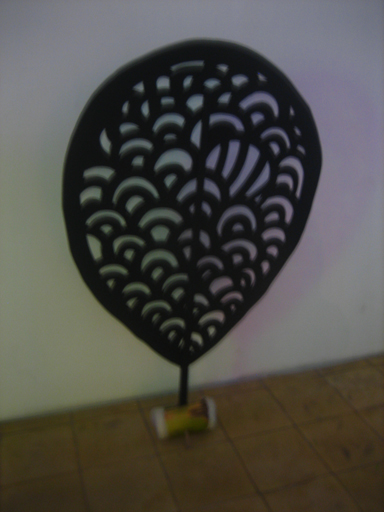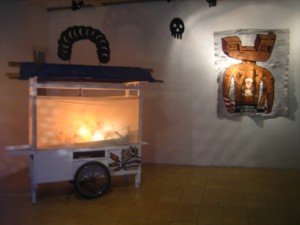


Eko Nugroho
Hidden Violence
Cemeti Art House
17 March – 18 April 2009
On view now in Cemeti Art House, Jogjakarta, is Eko Nugroho’s spell-binding foray into the world of wayang (shadow puppetry), exploring a centuries-old performance medium that functions both as popular entertainment and as a form of culturally sacrosanct art in his ever expanding body of experimentation with different representational formats. What is wonderful about Hidden Violence is that it does not regurgitate the tropes that are now familiarly Eko’s without offering a different layer of emphatic reading of his art, aided by the performative nature of the wayang.

Image courtesy of Cemeti Art House
I have always thought what is interesting about Eko’s work is the process in which turbulence, instability and violence are abstracted into a bizarre coterie of cartoon characters who are cute enough to offset the weightiness of the subject he deals with yet at the same time strange and impressionable enough to hint at the kind of tension underlying the crisis (social, political, emotional) we face today.
Eko’s aliens and mutant-beings signify a shift in the way we imagine ourselves to be, from a humanist notion of mankind into a post-human idea of the unstable human identity. Morphing beings, cyborgs, mutants are indicators of the inevitable transformation we all undergo as political, technological or environmental factors of our time altered the Western belief in the stable rationalist human. Part of this change that we experience on both personal and societal levels are the attendant sense of anxiety, frustration, struggle and violence. Because the plot of a wayang is driven by strife and struggle (between light and darkness, good and evil), it is a medium that intensifies Eko’s message, by operating on a format that has a parallel structure to articulate the conflictual violence central to Eko’s concerns.

The installation as a whole suggests the atmosphere of a night-market, with carnival rides, food-stalls, a wayang performance stage, exuding a nostalgic flavour to the show. They evoke a communal access to culture and entertainment, which has today given way to a homogenised passive absorption of modern day pop culture. Surreal, dream-like and sentimental, the installation does not fall short in its supporting role, lulling the audience into the wayang’s dream-world, existing in another space and another time.

One work particularly stood out. It is an interactive sound and light installation, which required the audience to manipulate the two available Playstation consoles that emit different sounds and noises at the push of the buttons. While the lit screen display two wayang inspired characters charging at each other, their combat is aurally activated by the audience’s operation of the consoles, creating a cacophonous counterpoint of gun-rays, digital beeps and silly noises.
Wayang, so deeply embedded withn Javanese cultural tradition, becomes a vehicle for Eko’s cavalcade of spacemen, mutants and cyborgs. Be that as it may, to read this as a dichotomy between adopting a traditional form into contemporary art is misleading at best. Indonesian wayang generally engages with the times on much more flexible and innovative terms. The country’s richer development in wayang practice, compared to its Southeast Asian counterparts, has produced a history of performances that manifest in a great variety of genres that are responsive to specific histories and contexts including examples such as wayang agresi (wayang about agression) and wayang revolution (wayang made during and for the Indonesian revolution). Wayang in Indonesia seems to be a medium that has continuously reinvented itself to suit particular needs in history.

Though I have regretfully missed the live performance which was held in Cemeti Art House the week before the exhibition opened, a documentary video of the performance conveyed pretty much what I imagined the atmosphere to be. Packed to a full house, a boisterous crowd was cajoled and humoured by entertainers par excellence. The video captured the vibe of a lively small town carnival, an appreciative crowd huddling around story-tellers who are able to translate, what is considered by some to be, a perennial struggle into a narrative and a resolve that are accessible enough for the common man yet rich enough to embody the values that a community, as a whole, upholds.
But what makes this such an enjoyable and thought-provoking exhibition is the fact that the wayang when contemporanised does not fall back into high-art/low-art discourse. By using a form that is constantly reinvented, Eko is able to marry it to an installation that allows us to experience a performance tradition that is at once populist and aesthetically sophisticated; setting the stage to address current day imperatives, at the same time, providing us with the critical distance to reflect upon these issues raised. Which is, I guess, what good theatre is all about – purporting a crisis, which results in a cathartic experience.
(SS)
No comments yet.
Sorry, the comment form is closed at this time.